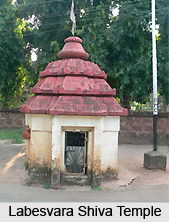 Labesvara Shiva Temple, dating back to the 14th century, is an architectural beauty of Bhubaneshwar in the Indian state of Orissa. The temple is located at latitude 20°15` 22" N and longitude 85 °50` 18" E at an elevation of 84 ft above the sea level. Positioned in the close propinquity to the Ramesvara temple, this ancient religious edifice is dedicated to Lord Shiva. The temple facing the western side enshrines a Shivalingam within a circular yonipitha in its sanctum sanctorum or garbhagriha. The temple is surrounded on its western side by the Ramesvara temple located at a distance of 10 metres while the Laxmanesvara group of Shiva temple rules the eastern side at a distance of 30 metres across the road. The Mausima chowk on its south is at a distance of 50 metres.
Labesvara Shiva Temple, dating back to the 14th century, is an architectural beauty of Bhubaneshwar in the Indian state of Orissa. The temple is located at latitude 20°15` 22" N and longitude 85 °50` 18" E at an elevation of 84 ft above the sea level. Positioned in the close propinquity to the Ramesvara temple, this ancient religious edifice is dedicated to Lord Shiva. The temple facing the western side enshrines a Shivalingam within a circular yonipitha in its sanctum sanctorum or garbhagriha. The temple is surrounded on its western side by the Ramesvara temple located at a distance of 10 metres while the Laxmanesvara group of Shiva temple rules the eastern side at a distance of 30 metres across the road. The Mausima chowk on its south is at a distance of 50 metres.
Architecture of Labesvara Shiva Temple
Labesvara Shiva Temple, an illustration of the architectural opulence of the ancient period, is known for its elite construction techniques. The temple built primarily of sand stone, on plan boasts of a vimana measuring 3.10 metres adorned with a frontal porch measuring 0.35 metres. The temple projects pidha order on elevation while it is pancharatha on plan that measures 5.04 metres in height. The orientation suggests a partially buried building with its pabhaga measuring 0.30 metres, its baranda measuring 0.45 metres and its jangha measuring 1.08 metres. The construction techniques employed for the temple is of dry masonry type. The temple embellished by a gandi features three tiers organised in receding order measures 2.00 metres while the mastaka measures 1.00 metres.
Labesvara Shiva Temple, identified for its stylistic depiction of architectural pattern, is marked by delicately carved raha niche and parsva devatas. The later niches measuring 0.51 metres x 0.31 metres x 0.19 metres enshrine an idol of Parvati in its northern side while its eastern side is occupied by an image of Kartikeya. A ruined image of Lord Ganesha inhabits the southern side of the shrine.
The architecturally rich Labesvara Shiva Temple demands further approbation and admiration for eulogizing the splendor of primeval craftsmanship that gets reflected though the door jambs carved delightfully. Three vertical bands measuring 1.45 metres in height and 0.56 metres in width with modest designs defines the doorjambs. An enchanting image of Gajalaxmi seated over a lotus pedestal in padmasana posture at the lalatabimba. Her right hands depict varada mudra and left hand holds a lotus flower. The deity is flanked by two elephants that are seen pouring water on the deity.
Presently, the temple is exhibiting signs of deterioration. Cracks have developed in the roof through which the rain permeates and percolates in the sanctum. The rainy season encourages road water to seep into the sanctum. Even the gandi of the temple has developed significant cracks. Growth of wild vegetations in the eastern wall of the gandi has led to further conservation problem of the temple.





















